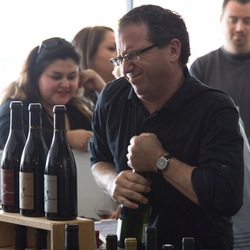Rebellion On Your Own Terms
Jean-Claude Bessin
La Forêt Chablis 1er Cru Chardonnay 2011
Not your usual Chardonnay ! Clear, star bright, medium low intensity, straw color , medium plus viscosity. Green apple nose, grassy, citrus and mineral flavors, a little cream / butter, full bodied but crisp. Odd because it still retains the flavors of malo / lees and the body consistent with the grape yet lacking the concentration, coupled with the racy acidity one would expect from an area so far north. Pairs well with rich foods. Refreshing and crisp but able to stand up on its own. — 11 years ago
Mossik
White Rock Vineyard JouJou Cabernet Franc 2011
Jou Jou Vin 2011 Mossik Cabernet Franc from White Rock Vineyard, Napa Valley. It's always difficult when tasting friends wines to remain objective, and while I want to shout this wine from the hilltops (Radio-Coteau style!) I also want to be I also aspire to eliminate personal biases - positive or negative. Jou Jou you should know your wine received much conversation towards a mostly positive frame. The touch of brettanomyces was dually noted, there were comments on carbonic maceration, but I found balance throughout. I jested about the wine being topped with Baudry La Croix Boissée but the fact is, this wine has a strain of brett that works well with the fruit. The brett adds a spicy, wet earth, or mulchy wet tobacco leaf component that lends itself to wines of Chinon or Bordeaux. Is that replicable? Future vintages will tell. Will it grow in bottle? I plan to drink many more for my own recognizance. First day had some notes of carbonic maceration and brighter red fruits, along with that leafy Cab Franc character, fine dense tannins and moderate acidity with a slight sour note likely a proponent of brett. Day 2: I'll be damned. This is some damn good shit. It's worth that $250 dollar price tag! ;) But truly, the leaf/mulch quality is intact and integral, the darker berry fruits come out but there is still a pleasant sour cherry mid-palate that combines with the albeit softer yet still dense/fine mouth filling tannins. I realize part of the reason this wine was the talk of the blind tasting was that the brett, while in balance, set it apart from every other wine tasted. It was unique, it spoke of an older world style, it crept up in conversation because it lent something else to talk about. Kudos Jou Jou. The wine was made from 12 year old CF vines farmed organically (uncertified) grown in a layer of white volcanic ash. Grapes are fermented WC with ambient yeast in open top macro-bins, gently foot tread, native ML, pressed dry into 75% neutral FO and 25% Stainless Steel. 50 ppm SO2 added post ML, 10-15ppm added before bottling, racked once to bottle in June 2012. 25 cases produced. Good luck finding some! — 13 years ago
Mountford Village
Waipara Pinot Noir 2000
Past it's prime, but certainly has a bit of life left if you prefer your pinot noir more on the savory side. Has an intriguing red bean quality to it. Unique and still tasty in it's own way. — 11 years ago
Château d'Yquem
Sauternes Sémillon-Sauvignon Blanc Blend 1979
Contrary to other wines, D'yquem is in a class of it's own in terms of Sauternes. There is rarely, if ever, a bad year, although some years, like the 2001, stand out more than others. The disparity in quality from a GREAT d'yquem to a mediocre one & so on isn't as drastic as one might imagine. While the older vintages seem to age VERY well, it isn't as discernible from a recent vintage as other wines. Sauternes, in general are consistent, & none more than d'yquem. — 12 years ago
Samsara Wine Co.
Rancho la Viña Vineyard Pinot Noir 2010
In your face flavor and depth not quite expected of a 2010. Fruity like a California wine, but much more complex than most wines that focus on the fruit-forward. Has a tangy edge to it, but also a loamy warmth that you would probably smell in a humid, misty forest that gets plenty of rain and has lots of moss growing on the trees. Easy to drink on its own, medium-bodied. — 12 years ago
Gérard Raphet
Lavaux St. Jacques Cuvée Unique Gevrey-Chambertin 1er Cru Pinot Noir
A wine that goes both ways: as a standalone, I want to enjoy as a glass on it's' own or with your favorite light fare dish. Overall this is a 10. — 12 years ago
Cantillon Brewery
Zwanze Tripel 2013
Jean Van Roy's amazing story of Zwanze 2013. When we started renovation works in the cellars of the brewery two years ago, much to our surprise we came upon the remains of some very old walls. In agreement with the medievalists of the city of Brussels, the works were stopped in order to allow archaeological excavations to take place.
Shortly thereafter we were astonished to find out that Cantillon brewery had in fact been built on the ruins of the very ancient Abbey of Cureghem! According to the medievalists, this religious community was well-known during the middle ages for its fowl fed on draff and, more specifically, for its dish of stuffed Cureghem capon, which was served with a beer brewed at the abbey and apparently drew pilgrims from all over Europe.
Yet it was truly a heavenly surprise when the excavations uncovered the cell of the abbot, Father Faro. In the small room the archaeologists found quite a few old reference books, one of which contained the original recipes for the beers brewed at the abbey several hundred years ago. We didn’t hesitate for a second and decided on the spot to recreate one of these mythical beers.
This beer, which will be our Zwanze for 2013, therefore bears the name of its illustrious place of origin, Abbaye de Cureghem (Cureghem Abbey). Cureghem was formerly a village established many centuries ago on the banks of the Senne, the river running through present-day Brussels. The area was very heavily industrialised during the 19th century and, among other things, became home to many breweries. Today, it is part of the municipality of Anderlecht.
Since beers commonly referred to as “abbey beers” are not, or not any longer, products of spontaneous fermentation, we decided to brew a top fermentation beer, from a technical point of view in any case. The yeasts were selected in collaboration with Institut Meurice, a post-secondary college in Brussels specialising in biotechnology. Brewed in March 2012, our “Cureghem” beer fermented four weeks in stainless steel tanks before being blended with 10% lambic and pumped into 400-litre barrels of various origins. After maturing for six months, the beers were blended and put into casks or bottles to undergo re-fermentation and reach 7.2% ABV (Alcohol by Volume).
Inevitably, a top fermentation beer brewed in a spontaneous fermentation environment will be affected by the wild yeasts in the air, and this is certainly what happened in our case. For our Cureghem, the cultured yeasts were clearly the main factor behind primary fermentation and I think that the wild yeasts in the beer will instead play an increasingly important role as the product ages. However, despite the addition of the lambic to give it a little “extra something” in terms of character and ageing characteristics, this Zwanze cannot in any case be considered a spontaneous fermentation beer.
The long fermentation period coupled with the presence of wild yeasts lends this beer a solid character with a dry finish that lingers on the palate, while the combined use of fresh and aged hops yields both freshness and bitterness. Moreover, the different malts used give this year’s Zwanze a coppery colour along with a touch of caramel and candied fruit that provide body. Clearly, this is not your standard “abbey” beer but, perhaps, it is representative of what these beers were one or two hundred years ago — 12 years ago











Cathern Cooper
Cathern had this 11 years ago